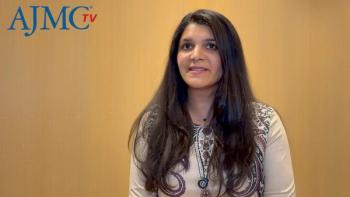
Belantamab Mafodotin Can Help Fill Access Gaps in BCMA-Directed Myeloma Therapy: Hearn Jay Cho, MD, PhD
Belantamab mafodotin provides a community-friendly BCMA-directed therapy option for relapsed/refractory myeloma, says Hearn Jay Cho, MD, PhD.
Despite significant advances in the treatment of multiple myeloma in recent years, some of the most cutting-edge treatments—like B-cell maturation antigen (BCMA)–directed chimeric antigen receptor (CAR) T-cell therapies and bispecific antibodies—are not easily accessible to patients receiving care in the community setting, said Hearn Jay Cho, MD, PhD, chief medical officer at the Multiple Myeloma Research Foundation.
The
Cho spoke with The American Journal of Managed Care® (AJMC®) to discuss how the approval of belantamab mafodotin may change the myeloma treatment landscape, especially in the community.
This transcript has been lightly edited; captions are auto-generated.
Transcript
How do you anticipate belantamab mafodotin will be incorporated into the treatment algorithm for relapsed/refractory myeloma?
I foresee that [belantamab mafodotin] is going to play a role, probably in third-line and beyond treatment, and that is similar to the indications for the other BCMA-directed agents. An important point here, though, is that both BCMA-directed CAR T cells and bispecifics are not readily available out in the community. CAR T cells obviously need a transplant center, and there's an inpatient stay of up to 2 weeks. Bispecifics, for the most part, require some inpatient hospitalization for the step-up dosing and therefore a facility that is comfortable managing cytokine release syndrome or ICANS and similar side effects. And as of now, there is no universally accepted outpatient step-up dosing regimen, and to do so in the community is going to be quite difficult.
But there's still a large need for BCMA-directed agents, because most myeloma patients are getting proteasome inhibitors, IMiDs [immunomodulatory drugs], and CD38-directed agents In their first 2 lines of therapy. Once those best-in-class options are exhausted, there's a real need for second-, third-, and fourth-line therapies that are going to be effective and that can be delivered in the community. [Belantamab mafodotin], in that setting, is an effective BCMA-directed agent that can be delivered out in the community. There's no CRS risk; it does not require hospitalization. It can be delivered in an office or infusion center. I foresee that there's going to be a fairly sizable portion of the myeloma community that gets their care out in community medical centers and community practices that are going to need access to something like [belantamab mafodotin].
How would you position belantamab mafodotin among the growing number of BCMA-targeted therapies—CAR-T, bispecifics, and other ADCs—in terms of mechanism, advantages or limitations, and sequencing?
Sequencing is an important question, because it's pretty clear that one mechanism of relapse after any BCMA-directed therapy is either downregulation or mutation in the BCMA target itself. This is a hot area of research. There are no conclusive answers yet. There's also the biological issues; for example, for both bispecifics and CAR T cells, T cell exhaustion is an important feature associated with relapse after these therapies, and T cell fitness going into these therapies is also important. How you position the therapies, and vis-à-vis how they affect T-cell function, becomes a critical consideration, and there's a lot of research being done now in patients who've received both CAR T cells and bispecifics to see, are the outcomes better with one sequence vs the other?
I would like to see more research in sequencing these agents for success. In other words, how do you combine these 2 classes of agents, CAR Ts and bispecifics, to get better outcomes? And now we're adding ADCs into the mix. ADCs, strictly speaking, don't directly affect T cell function, so are these things that can be potentially safely combined with some of the T cell–redirection therapies? Can they come before or after safely? These are important questions. We don't really know the answer in terms of sequencing yet, and we don't know the optimal way to sequence yet. I think this is an important area of research.
Reference
McNulty R. FDA approves belantamab mafodotin combos for relapsed or refractory multiple myeloma. AJMC. October 23, 2025. Accessed October 23, 2025.
Newsletter
Stay ahead of policy, cost, and value—subscribe to AJMC for expert insights at the intersection of clinical care and health economics.













































